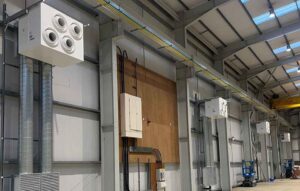Temperatures rise over chilled beam report
28th July 2013The ‘Technical Fact Sheet’ is due to be officially launched tomorrow (Monday) at the Building Centre in London. It compares the energy consumption, CO2 emissions and running costs of passive and active chilled beams with VAV fan coils utilising EC motors.
Published by the Chilled Beam & Ceiling Association (CBCA), it has brought condemnation from manufacturers of fan coils, one describing it as a “biased” and a “selectively worded sales document”.
Based on modeling by EDSL Tas software, the study looks at four differently-sized office buildings in London and Birmingham with all three hvac systems being supplied by a high efficiency chiller. An air source heat pump was modeled to supply heating and cooling to the dx coils in the ahu which included heat recovery.
The completed energy study shows greater energy savings for both the active and passive chilled beams compared to fan coils. Over all the building types the average annual savings over fan coils were found to be about 17% for passive beams and around 22% for active chilled beams.
Fan coil manufacturer Ability Projects is not impressed with the results. The company’s website calls the report “a selectively worded sales document” and “biased towards the products of the manufacturers association that sponsored it.”
Specifically, it maintains that the efficiency benefits attributed to the beams are as a result of running them at water temperatures of 14-17ºC, whereas the fan coils were modeled at 6-12ºC.
“What the report does not suggest once is that fan coil units can, of course, also use the same elevated temperatures and so would also get the same beneficial chiller COPs,” says Ability Projects.
Ability Projects also maintains that the report fails to take into account that active beams require more system pressure to operate so will have a higher specific fan power than both the passive chilled beams and fan coils.
It also says that the study appears to give the VAV fan coils a constant specific fan power of 0.25W/(l/s).
“Most fixed speed fan coils as installed will be drawing more in the region of 0.2W/(l/s) and with a VAV strategy in place will for the most part be drawing far less than that,” argues Ability Projects. “If the VAV SFP values used accounted for the VAV strategy, then the fan energy reported for a year would be far less.”








